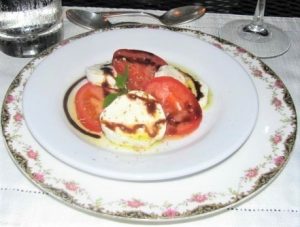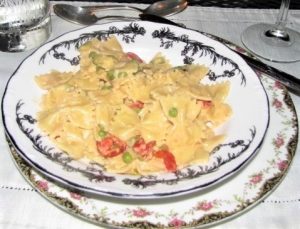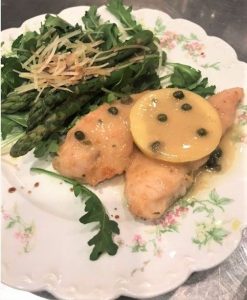The Orangery
Tuscan Cuisine at Glen Isle
130 South Lloyd Avenue
Downingtown, Pennsylvania
(484) 401-5554
http://www.orangeryatglenisle.com/
 Tucked away in Glen Isle, a bit of bucolic bliss just off bustling Business Route 30 on the western fringe of Downingtown, the Orangery is a secluded little restaurant retreat that has continued to charm and delight patrons from the moment of its debut in September 2011.
Tucked away in Glen Isle, a bit of bucolic bliss just off bustling Business Route 30 on the western fringe of Downingtown, the Orangery is a secluded little restaurant retreat that has continued to charm and delight patrons from the moment of its debut in September 2011.
It is very much a world apart… Drive down a narrow gravel lane and park your car in an unpaved lot next to the stone ruins of an old dairy barn. Then a brief jaunt to the restaurant itself, a stately stucco mansion, which is also the residence of head chef Sabrina Lutz and her husband, Paul. The 40-seat main dining room, an enclosed sunporch, is quite cozy… On the other hand, in warmer weather, you may wish to take advantage of the restaurant’s comfortable patio to dine alfresco.
The Orangery is open Thursday – Saturday with one seating only at 6:30 p.m. The set menu of Tuscan cuisine changes fortnightly, so the menu my dining partner and I recently enjoyed – along with twenty-two other members of her community – may be different from what you will experience. This will, however, give you some idea of what to expect…
 Our five-course meal commenced with Sweet Peppers Crostini (pictured), which was really something of a misnomer. The word crostini in Italian means “little toasts.” This generally describes canapés consisting of small slices of toast adorned with some sort of savory topping. However, what was served here was a rather large thick slice of Italian bread that was definitely not toasted… On the other hand, the topping of delightfully seasoned roasted sweet red peppers was so utterly delicious that no one – especially this writer – was about to quibble over semantics.
Our five-course meal commenced with Sweet Peppers Crostini (pictured), which was really something of a misnomer. The word crostini in Italian means “little toasts.” This generally describes canapés consisting of small slices of toast adorned with some sort of savory topping. However, what was served here was a rather large thick slice of Italian bread that was definitely not toasted… On the other hand, the topping of delightfully seasoned roasted sweet red peppers was so utterly delicious that no one – especially this writer – was about to quibble over semantics.
 Next on the agenda was the Caprese (pictured), an Italian salad comprised of slices of fresh mozzarella & tomatoes interspersed with sweet basil leaves. It is generally minimally seasoned with just a pinch of salt and extra-virgin olive oil. And, as you will notice, like Pizza Margherita, it features the colors of the Italian flag: green, white, and red.
Next on the agenda was the Caprese (pictured), an Italian salad comprised of slices of fresh mozzarella & tomatoes interspersed with sweet basil leaves. It is generally minimally seasoned with just a pinch of salt and extra-virgin olive oil. And, as you will notice, like Pizza Margherita, it features the colors of the Italian flag: green, white, and red.
There are many variations on the theme, of course; but the less convoluted, in my opinion, the better. And this is a particularly nice presentation… artfully yet simply arranged with a splash of balsamic reduction adding a sweet/tangy kick to the proceedings.
 Regardless of what the main course may be, the menu always includes a pasta course. The evening of our visit it was the Butterfly Pasta Primavera (pictured). This is also commonly known as bowtie pasta, but more properly as Farfalle, the name being derived from the Italian word for butterflies. The versatile bowtie shaped noodle originated in the Lombardy & Emilia-Romagna regions of northern Italy and is best with lighter and creamy sauces.
Regardless of what the main course may be, the menu always includes a pasta course. The evening of our visit it was the Butterfly Pasta Primavera (pictured). This is also commonly known as bowtie pasta, but more properly as Farfalle, the name being derived from the Italian word for butterflies. The versatile bowtie shaped noodle originated in the Lombardy & Emilia-Romagna regions of northern Italy and is best with lighter and creamy sauces.
Interestingly enough, while the restaurant prides itself on the presentation of authentic Tuscan cuisine, pasta primavera is an American dish invented in the 1970s. While the actual invention of the dish is contested… In 1975, or so the story goes, New York restaurateur Sirio Maccioni and his two top chefs flew to the Canadian summer home of Italian Baron Carlo Amato on Robert’s Island, Nova Scotia. They began experimenting with fish and game, but the Baron and his guests requested something different. So Maccioni then mixed butter, cream and cheese with vegetables and pasta and brought the recipe back to New York City. The fame of pasta primavera may be traced to Maccioni’s restaurant Le Cirque, where it first appeared as an unlisted special before it was made famous via a 1977 article in the New York Times by Craig Claiborne and Pierre Franey, which also included a recipe for the dish. Pasta primavera is now widely recognized as one of the signature developments of American cuisine in the 1970s.
Unfortunately, the presentation encountered here was quite disappointing and, culinarily speaking, the weakest part of our meal. For starters, in the midst of a five-course meal, unless you happen to possess the appetite of a starving yak, the portion size was entirely too large. Secondly (as you may note from the photograph), it was not terribly attractively plated. In addition, the primavera portion – namely, the vegetables – was nearly conspicuous by its absence. And, perhaps most importantly, the dish was woefully under-seasoned. In point of fact, it was completely bland. At the very least, a generous sprinkling of parmesan would have mitigated the situation significantly.
 Conversely, the main course, Chicken Scaloppini embellished with lemon and capers (pictured), was quite good. The chicken was nicely presented, perfectly prepared – incredibly moist and tender – and the lemon sauce irresistibly flavorful. My only quibble here… I thought the organic green salad with asparagus and parmesan cheese a rather odd, and not particularly well-chosen, plating companion. My preference would have been for a wild rice pilaf and a nicely arranged green vegetable (perhaps the asparagus, sans superfluous greenery), both of which would have made more appropriate accompaniments.
Conversely, the main course, Chicken Scaloppini embellished with lemon and capers (pictured), was quite good. The chicken was nicely presented, perfectly prepared – incredibly moist and tender – and the lemon sauce irresistibly flavorful. My only quibble here… I thought the organic green salad with asparagus and parmesan cheese a rather odd, and not particularly well-chosen, plating companion. My preference would have been for a wild rice pilaf and a nicely arranged green vegetable (perhaps the asparagus, sans superfluous greenery), both of which would have made more appropriate accompaniments.
 The desserts – at least one – prompted a number of oohs & aahs from several members of our dining group. The Ricotta Cake, a classic Italian delicacy, was quite nice. The consistency of ricotta cake is slightly denser than that of traditional cake; and its texture has often been described as somewhere between regular cake and cheesecake. And that was true of Orangery’s version as well. Soft, moist, and buttery, it was simply garnished with powdered sugar and strawberry purée.
The desserts – at least one – prompted a number of oohs & aahs from several members of our dining group. The Ricotta Cake, a classic Italian delicacy, was quite nice. The consistency of ricotta cake is slightly denser than that of traditional cake; and its texture has often been described as somewhere between regular cake and cheesecake. And that was true of Orangery’s version as well. Soft, moist, and buttery, it was simply garnished with powdered sugar and strawberry purée.
 But the expressions of delight were reserved for the Affogato al Caffè. Originally invented in Italy, the word “affogato” may literally be translated as “drowned” in English. And this is a very apt description, as affogato is simply a scoop of vanilla gelato or ice cream “drowned” in espresso. While the recipe of affogato is basically standard in Italy, numerous variations exist in European and American restaurants.
But the expressions of delight were reserved for the Affogato al Caffè. Originally invented in Italy, the word “affogato” may literally be translated as “drowned” in English. And this is a very apt description, as affogato is simply a scoop of vanilla gelato or ice cream “drowned” in espresso. While the recipe of affogato is basically standard in Italy, numerous variations exist in European and American restaurants.
Occasionally, for example, coconut, berries, honeycomb, and multiple flavors of ice cream are added. A biscotto or cookie may also be served alongside. We were fortunate enough, however, to enjoy the unadulterated Italian version, which was thoroughly enjoyed by all. Well… not quite all… My dining partner doesn’t care for coffee. ☹
In a very real sense, the Orangery defies description… And your ultimate opinion of the restaurant – whether you love it or hate it – will very much depend upon your expectations going in. For example, if you’re anticipating a Michelin-starred experience, you’ve definitely come to the wrong address. The food here is homespun Tuscan and, with a few exceptions, it is quite good, though hardly exceptional. Service is on a par with the cuisine – meaning it is decidedly not professional. Servers are young, friendly, well-meaning, and accommodating… unfortunately, they appear to be completely unfamiliar with the complexities and subtle nuances of fine dining.
 If you have never dined at the Orangery, it is certainly, in my opinion, worthy of a visit… but neither for the food nor the service. Given its pastoral setting and homey, unpretentious ambiance, it is a delightfully restful step back in time that will do infinitely more to soothe the soul than appease the appetite. Just keep the above-mentioned caveats in mind and you will probably not be disappointed.
If you have never dined at the Orangery, it is certainly, in my opinion, worthy of a visit… but neither for the food nor the service. Given its pastoral setting and homey, unpretentious ambiance, it is a delightfully restful step back in time that will do infinitely more to soothe the soul than appease the appetite. Just keep the above-mentioned caveats in mind and you will probably not be disappointed.
Bon Appétit!
Be Safe & Stay Well
TAD

{ 0 comments… add one now }